Myths about the origin of Ukraine and the Ukrainians. Myth 3. Historically foreign flag of Ukraine
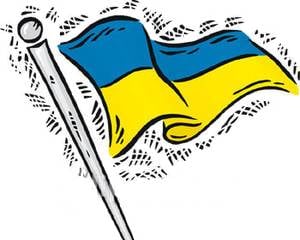
Officially, the meaning of the blue and yellow colors on the flag is traditionally interpreted as a combination of a clean, peaceful, cloudless sky over the yellow color of a grain field - a symbol of peaceful labor and well-being.
But even a superficial examination of this legend reveals the absurdity of pseudo-historical statements. Take at least Kievan Rus, although it has nothing to do with modern Ukraine. What color banners prevailed in the ancient Russian principalities?
In these principalities, the symbol of princely power was the banners, and from the 9th century on the lands now entering Ukraine, red, crimson, white always dominated in symbolism, less often blue and green, but not yellow-blue. For example, the Russian units that participated in the 1410 year in the Battle of Grunwald against the Teutonic Order, marched with banners of different colors. Yellow-blue color was peculiar only to Lviv, in the other detachments other colors of banners prevailed. So the lie about the dominance of the yellow-blue color of the banners in Kievan Rus is far-fetched.
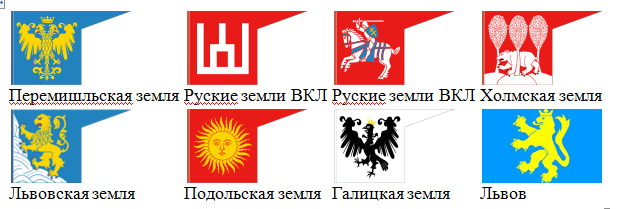
If we take the Kazatchina period, then all the assertions about the yellow-blue Cossack flags are also a lie. The banners of the Little Russian Cossacks, who considered and called themselves Russians, were dominated by the historical colors of Russia. Bogdan Khmelnitsky went into battle with a white banner in his left hand, and was followed by two general cornets with loose purple and white banners.
Not a word about the yellow color and the Trident is present either on the prapors of the regiments and hundreds of left-bank hetman and on the flags of the regiments of Slobozhanshchina. To distinguish between Cossack regiments and hundreds of flags, flags were used in different colors. This was caused not by their national differences, but by the military necessity for determining the place in the battle of one or another regiment or hundreds. So, the attempts to keep the history of the Ukrainian flag from the flags of Cossack hundreds and regiments is the blatant ignorance of their authors.
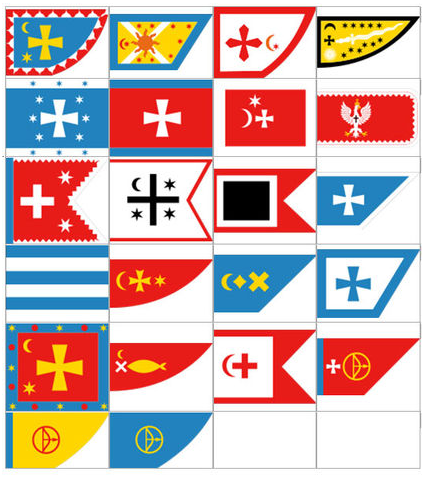

Where did the yellow-blue flag come from in Ukraine? It turns out that this myth, like all “Ukrainian”, was born in Galicia at that time in Austria and has no relation to the history of Ukrainian lands. This flag is not so ancient and it appeared in the middle of the XIX century. The combination of yellow-blue color of the flags is characteristic of the provinces of the Austrian Habsburg Empire - Dolmatia, Lower Austria, Galicia and Lodomería, and Russia-Ruthenia. All these lands were Austrian provinces and had no relation to big Russia. Galician Ruthenians received such a flag from the hands of the Austrian royal family for their faithful service.
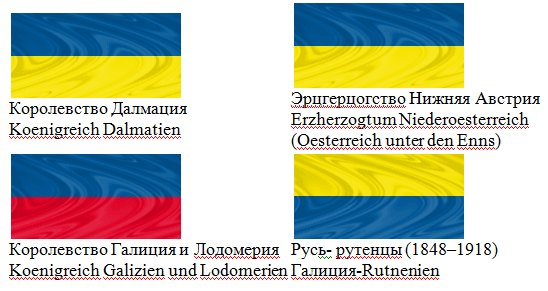
In 1848, a revolution broke out in Austria, and the emperor attracted to its suppression the Ruthenians of Galicia, who showed themselves well as punishers against the rebels. For the faithful service to Franz Joseph, they were honored by the last nickname “Tyroleans of the Middle East” and he granted them the yellow-blue flag as a symbol of the Galician regiment, and the Russian Council created by the Austrian authorities and loyal to them approved Galatians and called on the Ruthenians to support the emperor. According to one version, on the ribbon to the flag of the Rusins, the mother of the emperor, Archbishop Sophia, embroidered the slogan: “Loyalty leads to victory. Sophia, archknyaginya Austrian ".
As you can see, modern myth-makers are trying to make the symbol of loyalty to the Austrian throne a symbol of "independent Ukraine" and to hide the role of the Habsburgs in the history of its appearance. Cossacks with their regimental badges appeared as arguments much later, when the population of Little Russia had to invent a new story in which it would appear as a special non-Russian people on the outskirts of Poland.
On the territory of modern Ukraine, except Galicia, until 1914, this flag has never been some kind of symbol and, moreover, has not been used by any military, political, or social structures. Nobody knew anything about this flag on the territory of the Ukraine.
The yellow-blue flag reappears with Sich archers on the eve of the First World War. Under the Austrian command, units of the Ukrainian Sich Riflemen and other Galician formations are created, which the Austrian monarchy, under this flag, is preparing to conduct combat operations against the Russian army.
The emissaries of the archers under the leadership of Grushevsky are sent to Kiev to conduct subversive activities. They attract students from Kiev and organize a demonstration in March 1914 on the occasion of the celebration of Shevchenko, where they were held for the first time in the Ukraine under the yellow-blue flag. So the colors of the Habsburg Empire penetrated the territory of Little Russia and began to poison the life of the local population.
Sich Riflemen under this flag were defeated by Russian troops in 1915 on Mount Makovka. Ukrainian myth-makers try to present this defeat as a “great” victory of the Ukrainian weapons and instead of Victory Day, to celebrate 8 in May, the day of memory of the Sich Riflemen, teaching everyone to put on the graves of the fallen not carnations, but poppies.
The corps of the Sich Riflemen was eventually defeated by Russian troops, and many of the archers were captured, including Konovalets, the future head of the OUN. Immediately after the February Revolution, immigrants from Galicia establish a self-styled Central Council in Kiev, headed by Grushevsky (from 18 12 members were representatives of Galicia) and recruited former prisoners of the Sich Riflemen under the yellow-blue flag. Konovalets creates fighting units in Kiev in November 1917, which distinguished themselves by suppressing the Arsenal workers' uprising
When Hrushevsky was created in January 1918 of the Ukrainian People’s Republic, the flag of the Austrian province becomes the national flag of this operetta state. With the liquidation of the UNR, the flag passes to the hetman Skoropadsky, it changes colors on the contrary, but this does not help, and this regime has fallen. The next champion of separatism, Petliura, returned to the flag of the Ukrainian People's Republic on Polish bayonets, but the curse of Austrian flowers overtakes him, another pseudo-state has sunk into oblivion. In November, the 1918 of the year in Galicia is formed under this flag. The Ukrainian Galician Army, which befalls the same fate.
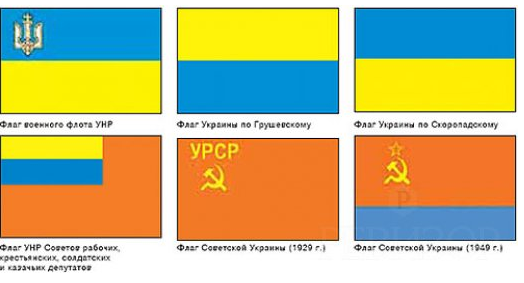
With the end of the civil war, the yellow-blue flag in the Ukrainian lands was almost forgotten; it was only used by the OUN fighters and in the foreign diaspora represented by people from Galicia. It re-emerges during the period of the Great Patriotic War and unites Ukrainian punishers and policemen.
Under this flag in the occupied Ukraine and Belarus, the punitive battalions "Nachtigall" and "Roland", the SS division "Galicia" and the ruthless beast of the UPA dealt with the civilian population. The yellow-blue flag fluttered beside the Hitler flag over all police stations and city councils and in the eyes of the population remained a symbol of betrayal and betrayal.
With the beginning of the next troubles at the end of 80's, the yellow-blue flag reappears, and not just anywhere, but at demonstrations in Galicia, in other regions, it was and remained an alien symbol. Gradually, under pressure from the Galician emissaries who flooded Kiev and the Supreme Soviet, this flag is being imposed as a symbol of independent Ukraine, and after the well-known events in Moscow in August 1991, on the wave of general permissiveness at the request of the RUH, it was raised above the building of the Supreme Soviet.
What should be the national flag of Ukraine, no one has ever publicly discussed. Backstage under the leadership of Kravchuk by the decree of the Presidium of the Supreme Council in September 1991, it was used in official events. Under pressure from the leadership of the Supreme Council, deputies in January 1992 of the year approved it as the state flag. So, the yellow-blue donation, presented by the Austrian monarch to the Sich archers of Galicia for the faithful service of the Habsburg crown during the suppression of the Hungarian uprising, became the national flag of Ukraine.
Information